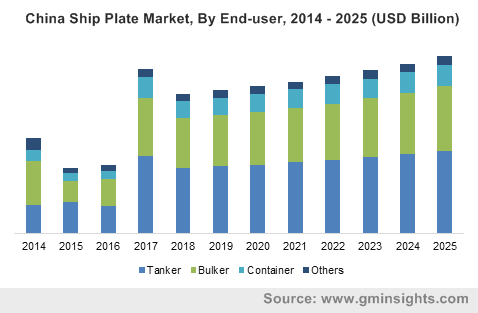Global Ship Plate Market size worth over $38bn by 2025
Published Date: July 2019
Ship Plate Market size will likely surpass USD 38 billion by 2025; according to a new research report by Global Market Insights Inc.
Robust product demand in rapidly increasing shipbuilding activities is going to be the major factor driving the growth of ship plate market. China and South Korea will collectively hold more than 70% market demand owing to the high new shipbuilding orders in these countries. Raw materials availability coupled with large number of product manufacturers will also boost the market growth.
Another factor propelling the ship plates market size is the increasing new orders in Europe. After a substantial downfall in 2016 globally, Europe has secured significant number of new shipbuilding orders in the succeeding year. For instance, Europe recorded over 60% of the global product demand for new cruise ships & passenger vessels in 2017. Presence of world-renowned cruise manufacturers such as Fincantieri, STX Offshore and Meyer Neptun, who have delivered more than 50% of the total cruise ship and passenger vessel orders in 2017, will help the region to secure more new shipbuilding orders in coming years, which will further augment the regional demand of ship plates.
Get more details on this report - Request Free Sample PDF
Browse key industry insights spread across 160 pages with 192 market data tables & 22 figures & charts from the report, “Ship Plate Market Size By Product (Carbon Steel, Stainless Steel), By Application (Tanker, Bulker, Container), Industry Analysis Report, Regional Outlook (U.S., Romania, Italy, Germany, The Netherlands, China, South Korea, Japan, Philippines, India, Brazil, UAE), Application Growth Potential, Price Trends, Competitive Market Share & Forecast, 2019 – 2025” in detail along with the table of contents: https://www.gminsights.com/industry-analysis/ship-plate-market
Based on the product type, market is classified into stainless-steel ship plates and carbon steel ship plates. Stainless steel product type will dominate the market owing to its extensive use in chemical carriers, tankers and containers. It can be attributed to the excellent mechanical characteristics and excellent corrosion resistance associated with the product type. Carbon steel ship plate market segment will have significant share during the forecast timeframe.
In the application segment, bulker will dominate throughout the forecast timeframe due to the tremendous rise in new order generation for the application segment. In 2017, bulker witnessed a growth of over 150% in the new generated orders as compared to that in 2016. Increasing transportation of coal, unpackaged bulk cargo, cement, ore, etc. will propel this application segment’s growth in the near future.
In the regional segments, Asia Pacific will dominate the market with more than 90% share throughout the forecast timeframe. It can be attributed to escalating shipbuilding activities, availability of shipbuilding infrastructure coupled with many manufacturers, government investment, etc. South Korea will enjoy the highest market share in the regional market. The three big shipbuilders in South Korea namely, Hyundai Heavy Industries, Daewoo Shipbuilding and Samsung Heavy Industries dominates the container ship segment. On the other hand, Europe will witness the highest CAGR during the forecast timeframe owing to the higher forward cover and recovery of new shipbuilding orders.
Some participants of ship plate market include JFE Steel, POSCO, Hyundai Steel, Nippon Steel, Essar Steel, Arcelor Mittal, Baosteel Group, Ansteel Group, Chapel Steel Corporation, etc. Varying the product price according to the market along with production capacity expansion are some of the strategies implemented by these major players.
Ship plate industry research report includes in-depth coverage of the industry with estimates & forecast in terms of volume in kilo tons & revenue in USD Million from 2014 to 2025, for the following segments:
Ship Plate Market Product By Application
- Carbon steel ship plate
- Tanker
- Bulker
- Container
- Others
- Stainless steel ship plate
- Tanker
- Bulker
- Container
- Others
Ship Plate Industry, By End-user
- Tanker
- Bulker
- Container
- Others
The above information is provided on a regional and country basis for the following:
- North America
- U.S.
- Europe
- Romania
- Italy
- Germany
- The Netherlands
- Asia Pacific
- China
- South Korea
- Japan
- Philippines
- India
- Latin America
- Brazil
- MEA
- UAE





